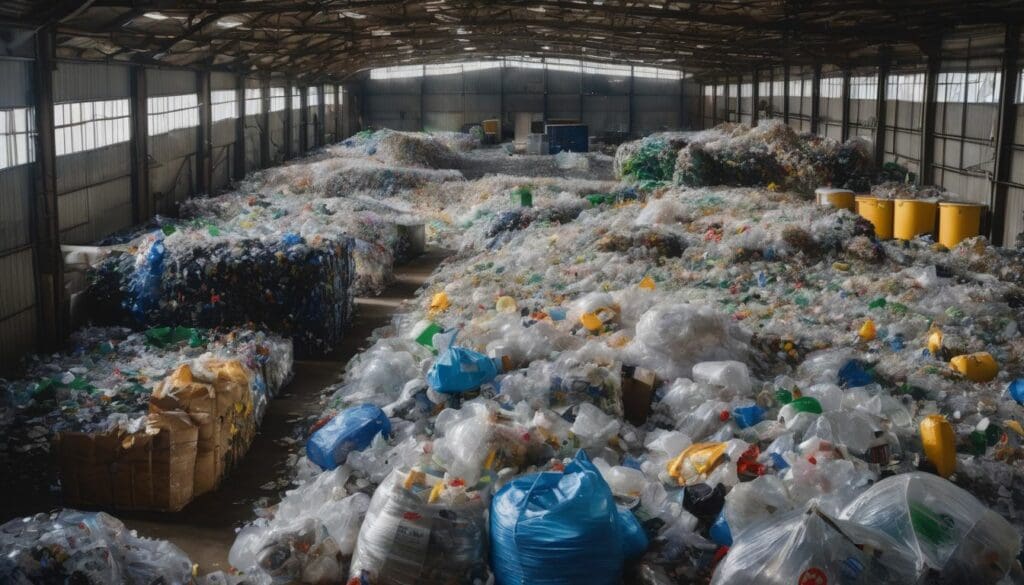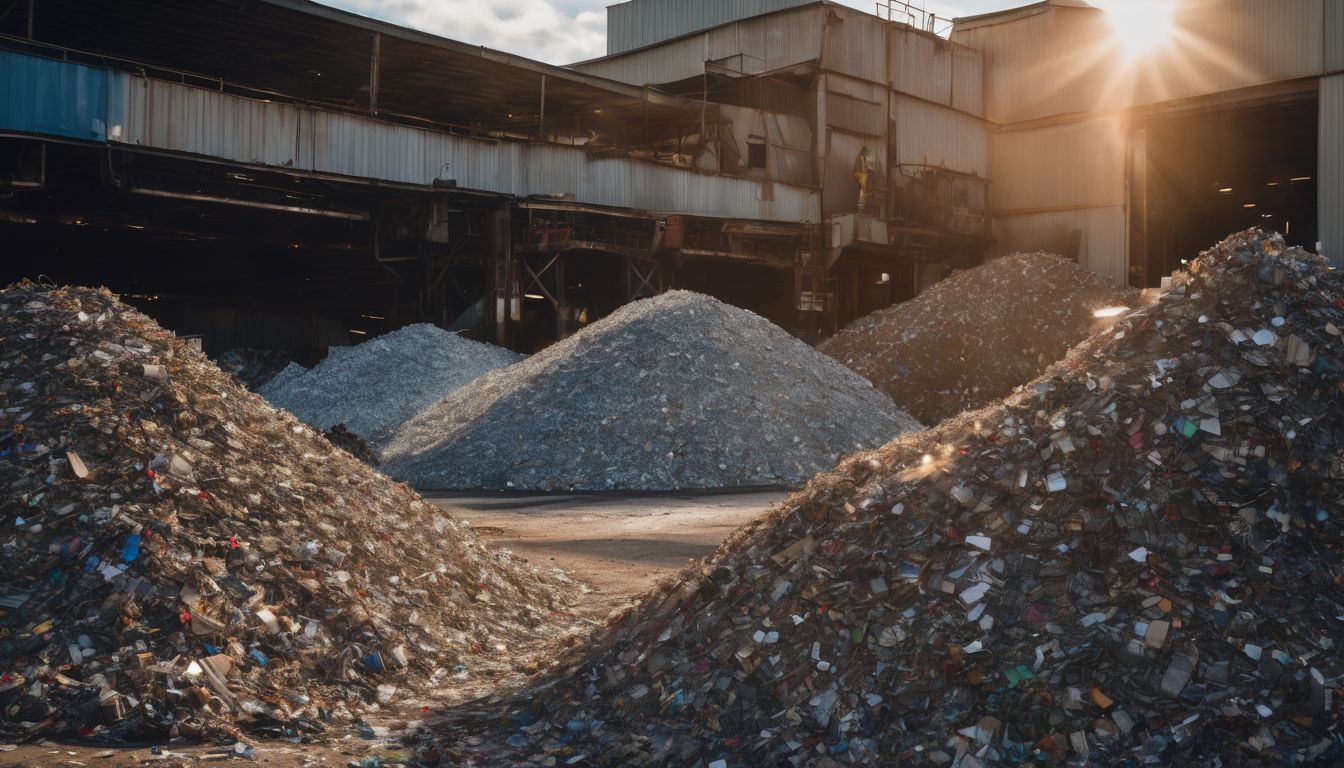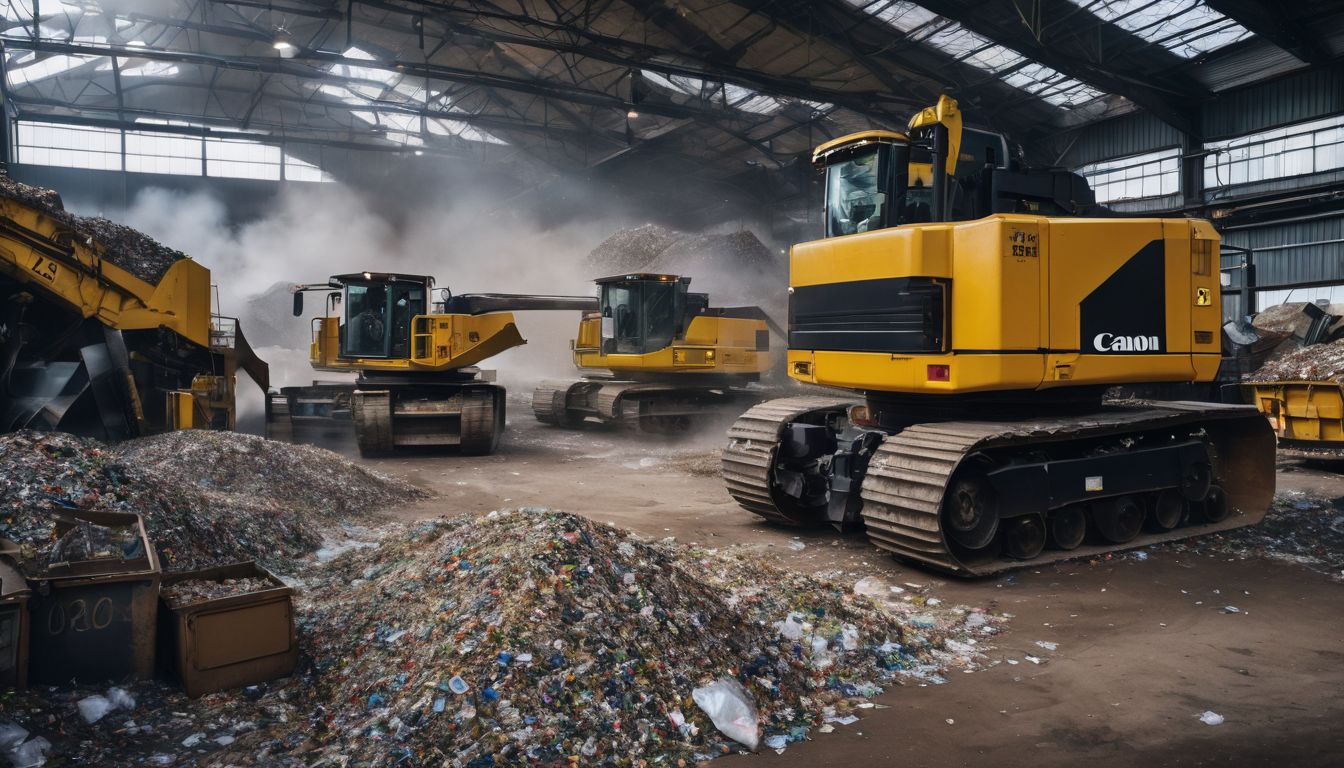Struggling to make sense of the recycling symbols on plastics? Every year, tons of plastic are recycled, yet much more ends up in landfills due to confusion. This guide will clarify those mystifying symbols and codes, empowering you with the knowledge to recycle effectively.
Dive in for a greener tomorrow!
Key Takeaways
- The “Chasing Arrows” symbol often seen on plastics indicates recyclability, but it’s important to check local guidelines as not all items can be recycled everywhere.
- Plastics are categorised with resin identification codes from 1 to 7, providing crucial information for proper recycling practices and disposal methods.
- Commonly recyclable plastics include PETG or PETE (Symbol 1), HDPE (Symbol 2), PVC or Vinyl (Symbol 3), LDPE (Symbol 4), PP (Symbol 5), and Styrene or PS (Symbol 6).
- Some plastic resins like PVC require special handling due to potential toxicity and are best taken to specialised recycling centres for safe processing.
- Active participation in correctly disposing of plastic materials based on their symbols supports environmental conservation efforts and promotes sustainable living.
Understanding Recycling Symbols
The “Chasing Arrows” symbol and resin identification codes are important indicators for understanding the recyclability of plastics. Recognising these symbols can help individuals make more informed decisions about how to properly dispose of plastic waste.
The “Chasing Arrows” Symbol
You’ve probably seen the “Chasing Arrows” symbol on various plastic items. It looks like three arrows that loop back on themselves and form a triangle. This emblem is easily misunderstood as a universal sign that an item can be recycled.
However, it’s actually more complex than just tossing the item in a recycling bin.
Each arrow in the symbol plays its own role: one for collection, another for remanufacture, and the third for purchasing recycled products. It encourages us to think beyond just disposal and consider how we can close the loop by buying products made from recycled materials.
While not every object with this symbol is recyclable everywhere, it serves as a prompt to check local regulations and support environmentally friendly practices by making smart choices about our waste.
Resin Identification Codes
Plastic items are marked with resin identification codes, also known as recycling symbols. These codes consist of a number inside the “chasing arrows” symbol and denote the type of plastic resin used in the product.
Understanding these codes is crucial for proper recycling practices. Each code represents a specific type of plastic, such as PET or PETE (Symbol 1), HDPE (Symbol 2), PVC or Vinyl (Symbol 3), LDPE (Symbol 4), PP (Symbol 5), Styrene or PS (Symbol 6) and Other (Symbol 7).
This knowledge enables environmentally conscious individuals to make informed decisions when it comes to disposal and recycling.
Recycling facilities rely on these resin identification codes to sort plastics effectively, making it important for consumers to be aware of them. By recognising these symbols and understanding their meaning, individuals can contribute towards efficient waste management and sustainable living.
Types of Plastic Resins
In this section, we’ll delve into the different types of plastic resins commonly used and their corresponding recycling symbols. Understanding these distinctions is crucial for proper disposal and recycling practices.
Let’s explore each type in detail to gain a better understanding of how to manage plastic waste effectively.
PETG or PETE (Symbol 1)
Symbol 1, also known as PETG or PETE, is commonly used to make plastic bottles for beverages. It’s a clear and tough material that is easily recyclable. When disposed of properly, it can be sorted and reprocessed into new products such as polyester fibers for clothing or packaging materials.
Recycling Symbol 1 encourages eco-friendly practices by promoting the recycling of plastic bottles rather than disposing them in landfills or oceans where they contribute to pollution.
By understanding the significance of this symbol, individuals can actively participate in conserving resources and supporting a circular economy.
HDPE (Symbol 2)
Moving on from PETG or PETE (Symbol 1), let’s focus on HDPE (Symbol 2). Commonly used in milk jugs, detergent bottles, and some plastic bags, HDPE is accepted by most recycling facilities.
It’s considered one of the safest forms of plastic when it comes to leaching chemicals into food and liquids. This makes it a popular choice for food storage containers and plastic packaging regulations.
When recycled, HDPE can be turned into new bottles, pens, flower pots, playground equipment, and more.
PVC or Vinyl (Symbol 3)
PVC or vinyl, identified by Symbol 3, is commonly used in various applications, including pipes, flooring, and packaging. It’s important to note that PVC can release toxic chemicals when burned or exposed to high temperatures.
This makes it crucial to dispose of PVC products properly through recycling for environmental safety.
When plastics like PVC are recycled, they can be turned into new products rather than being incinerated or ending up in landfills where they contribute to pollution. By recycling PVC items responsibly, we can reduce the environmental impact and conserve valuable resources for a sustainable future.
LDPE (Symbol 4)
Moving on from PVC or Vinyl (Symbol 3) to LDPE (Symbol 4), low-density polyethylene is commonly used in packaging, such as plastic bags and cling films. This type of plastic can be recycled, typically into new grocery bags and other film-type products.
It’s important to note that while LDPE is recyclable, it may not be accepted by all recycling programs due to its lightweight nature which can cause issues during the sorting process.
Moreover, LDPE is often found in shrink wraps around paper towels, bread bags, and fresh produce packaging. When considering the disposal of LDPE items, check with your local recycling program for specific guidelines on what they accept.
PP (Symbol 5)
PP, denoted by Symbol 5, represents polypropylene. This type of plastic is commonly found in food containers, bottle caps, and some types of packaging. It’s a versatile material that can be recycled into items such as storage bins, brooms, and automotive parts.
Polypropylene is widely accepted for recycling and can usually be included in curbside recycling programs. By separating PP plastics from other recyclables and making sure they are clean before disposal, individuals can effectively contribute to reducing plastic waste while supporting environmental conservation efforts.
Polypropylene (Symbol 5) is one of the easier plastics to recycle due to its high demand across various industries. Its versatility makes it an ideal candidate for repurposing into new products rather than ending up in landfills or polluting natural environments.
Styrene or PS (Symbol 6)
Moving on from PP, denoted by the recycling symbol 5, we have Styrene or PS (Symbol 6). Used in packaging and disposable cutlery, this clear, brittle plastic is also found in insulation and foam products.
While it’s not as commonly recyclable as some other materials, check with your local recycling centre to see if they accept Styrene or PS plastics for recycling. If not recycled properly, this plastic can contribute to environmental pollution.
With Symbol 6 plastics being less frequently accepted for recycling than other types, it’s important to minimise its usage whenever possible and explore alternative eco-friendly options to support conservation efforts.
Other (Symbol 7)
Continuing from the discussion of Styrene or PS (Symbol 6), Symbol 7, labeled as “Other,” encompasses a wide range of plastic resins that do not fit into the previous categories. These plastics include polycarbonate, BPA-containing plastics, and various other types.
Symbol 7 plastics are commonly found in electronic equipment cases, baby bottles, large water containers, and sports equipment. It is important to note that while some Symbol 7 plastics can be recycled through specific programs, others may not be recyclable due to their complex composition.
Therefore, it’s crucial to check with your local recycling facility or waste management authority for guidance on how to properly dispose of these items.
What Can be Recycled
Certain plastics can be recycled to help minimise environmental impact. Here is a list of commonly recyclable plastics and their corresponding symbols:
- PETG or PETE (Symbol 1): Commonly used in beverage bottles, food packaging, and household cleaners.
- HDPE (Symbol 2): Found in milk jugs, detergent bottles, shampoo bottles, and butter tubs.
- PVC or Vinyl (Symbol 3): Often used in pipes, window frames, and flooring.
- LDPE (Symbol 4): Used in grocery bags, dry cleaning bags, and flexible packaging.
- PP (Symbol 5): Found in yoghurt containers, syrup bottles, medicine bottles, and bottle caps.
- Styrene or PS (Symbol 6): Commonly used in disposable coffee cups and takeaway containers.
How to Properly Dispose of Each Plastic Resin
Conclusion
Understanding recycling symbols and codes is crucial in contributing to a sustainable environment. Educating ourselves about the different types of plastic resins and their proper disposal methods helps reduce plastic waste, preserving our planet for future generations.
By taking small steps, such as recycling plastics correctly, we can make a significant impact on reducing plastic pollution and conserving natural resources. With this knowledge, we can actively participate in promoting a healthier, cleaner world for all.
FAQs
1. What does the chasing arrows symbol on plastics mean?
The chasing arrows symbol, often seen on plastic items, helps identify the type of plastic for recycling purposes and guides you in proper plastic recycling.
2. Can all plastics with a recycling code be recycled?
Not always; some plastics may not be accepted at local facilities even if they have a recycling code. It’s best to check with your council’s glass and plastic recycling guidelines.
3. How do I understand the different recycling codes on plastics?
Each number inside the chasing arrows represents a specific type of material used in making the plastic item, which can affect how it is recycled.
4. Why is it important to follow these symbols and codes when recycling?
Understanding symbols and codes ensures smart plastics usage, reduces plastic pollution, and supports efficient glass and general waste recycling systems.





